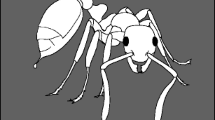Abstract
Colonies ofParachartergus colobopterus do not defend against vertebrates by attacking and stinging. Instead, defending workers bend the gaster forward and spray a fine mist of venom in the direction of nearby moving objects. Although venom spraying has been reported forP. fraternus, a species that does sting, we found that this occurred only during sting attempts. We conclude that defensive behavior inP. colobopterus is unique among wasps in that (1) venom is sprayed at intruders by workers standing on the nest and (2) the spray is an atomized mist rather than a stream. We suggest that nest crypticity restricts vertebrate predators on this wasp to small, insect gleaning birds, against which a spray of venom in the eyes, mouth, and nasal passages is more effective than is a stinging defense.
Similar content being viewed by others
References
Edwards, R. (1980).Social Wasps: Their Biology and Control, Rentokil, East Grinstead, W. Sussex, England.
Greene, A., Akre, R. D., and Landolt, P. J. (1976). The aerial yellowjacket,Dolichovespula arenaria (Fab.): Nesting biology, reproductive production, and behavior (Hymenoptera: Vespidae).Melanderia 26: 1–34.
Hermann, H. R., and Blum, M. S. (1981). Defensive mechanisms in the social Hymenoptera. In Hermann, H. R. (ed.),Social Insects, Academic Press, New York, Vol. II, pp. 78–197.
Hermann, H. R., Blum, M. S., and Fales, H. M. (1993). Venom spraying by a tropical polistine wasp (Hymenoptera: Vespidae: Polistinae).Sociobiology 23: 95–99.
Heselhaus, F. (1922). Die Hautdrüsen der Apiden und verwandter Formen.Zool. Jahrb. Abt. Anat. Ontog. Tiere 43: 369–464.
Jeanne, R. L. (1975). The adaptiveness of social wasp nest architecture.Q. Rev. Biol. 50: 267–287.
Jeanne, R. L. (1991). The swarm-founding Polistinae. In Ross, K. G., and Matthews, R. W. (eds.),The Social Biology of Wasps, Cornell University Press, Ithaca, NY, pp. 191–231.
Maschwitz, U. (1964). Gefahrenalarmstoffe und Gefahrenalarmierung bei sozialen Hymenopteren.Z. Vergl. Physiol. 47: 596–655.
Maschwitz, U. W. J., and Kloft, W. (1971). Morphology and function of the venom apparatus of insects—bees, wasps, ants, and caterpillars. In Bucherl, E., and Buckley, E. (eds.),Venomous Animals and Their Venoms, Vol. 3. Venomous Invertebrates, Academic Press, New York, pp. 1–60.
Matsuura, M., and Yamane, S. (1990).Biology of the Vespine Wasps, Springer-Verlag, Berlin.
Queller, D. C., Strassmann, J. E., and Hughes, C. R. (1988). Genetic relatedness in colonies of tropical wasps with multiple queens.Science 242: 1155–1157.
Reitz, R. D., and Bracco, F. V. (1986). Mechanisms of breakup of round liquid jets. InEncyclopedia of Fluid Mechanics, Gulf, Houston, TX, pp. 233–249.
Richards, O. W. (1978).The Social Wasps of the Americas, Excluding the Vespinae, British Museum (Natural History), London.
Richards, O. W., and Richards, M. J. (1951). Observations on the social wasps of South America (Hymenoptera Vespidae).Trans. R. Entomol. Soc. London 102: 1–170.
Sarmiento, G. (1983). The savannas of tropical America. In Bourlière, F. (ed.),Ecosystems of the World, 13: Tropical Savannas, Elsevier, Amsterdam, pp. 245–288.
Saslavasky, H., Ishay, J., and Ikan, R. (1973). Alarm substances as toxicants in the Oriental hornet colony.Life Sci. 12: 135–144.
Schmidt, J. O. (1992). Protection while collecting nests of pugnacious social wasps.Sphecos 23: 7–8.
Schremmer, F. (1978). Zum Einfluss verschiedener Nestunterlagen-Neigungen auf Nestform und Wabengrösse bei zwei neotropischen Arten sozialer Faltenwespen der GattungParachartergus (Hymenoptera: Vespidae).Ent. Germ. 4: 356–367.
Silveira, O. T., and Caetano, F. H. (1993). A morphometric study of sting glands in vespid wasps (Hymenoptera, Vespidae).Sociobiology 23: 45–62.
Spradbery, J. P. (1973).Wasps: An Account of the Biology and Natural History of Solitary and Social Wasps, University of Washington Press, Seattle.
Starr, C. K. (1985). A simple pain scale for field comparison of hymenopteran stings.J. Entomol. Sci. 20: 225–232.
Strassmann, J. E., Hughes, C. R., and Queller, D. C. (1990). Colony defense in the social wasp,Parachartergus colobopterus.Biotropica 22: 324–327.
Strassmann, J. E., Queller, D. C., Solís, C. R., and Hughes, C. R. (1991). Relatedness and queen number in the Neotropical wasp,Parachartergus colobopterus.Anim. Behav. 42: 461–470.
Author information
Authors and Affiliations
Rights and permissions
About this article
Cite this article
Jeanne, R.L., Keeping, M.G. Venom spraying inParachartergus colobopterus: A novel defensive behavior in a social wasp (Hymenoptera: Vespidae). J Insect Behav 8, 433–442 (1995). https://doi.org/10.1007/BF01995317
Accepted:
Issue Date:
DOI: https://doi.org/10.1007/BF01995317




